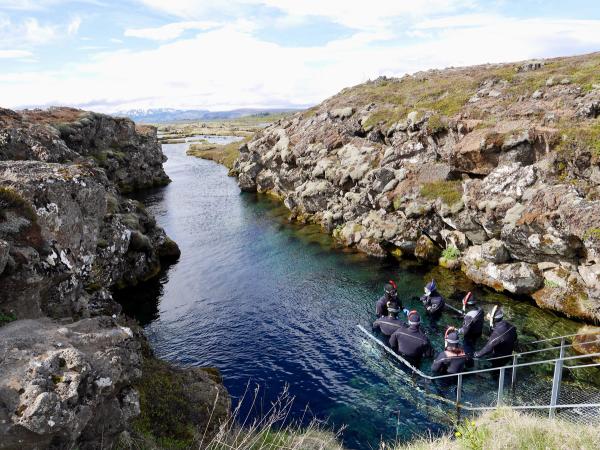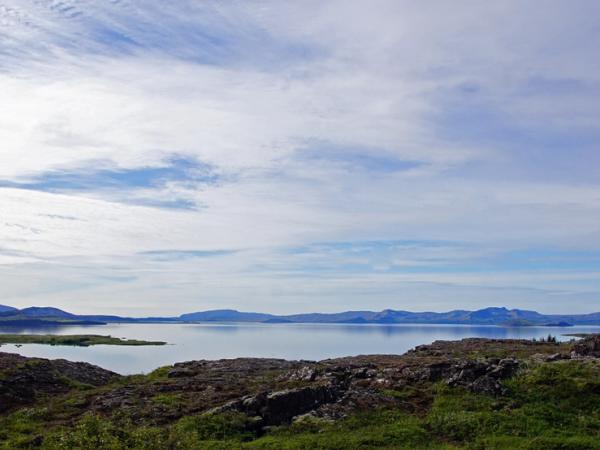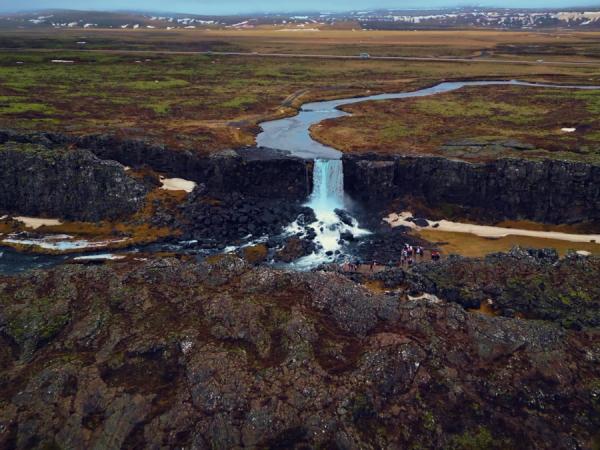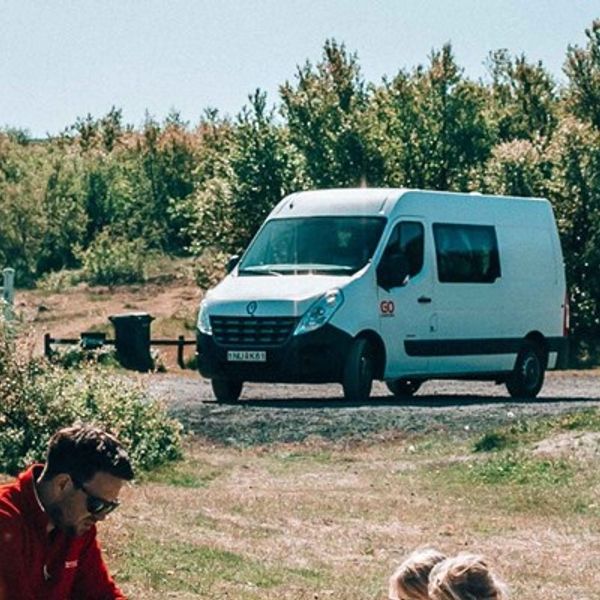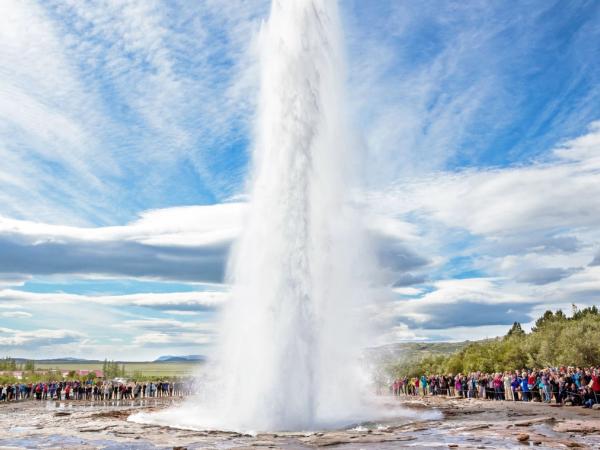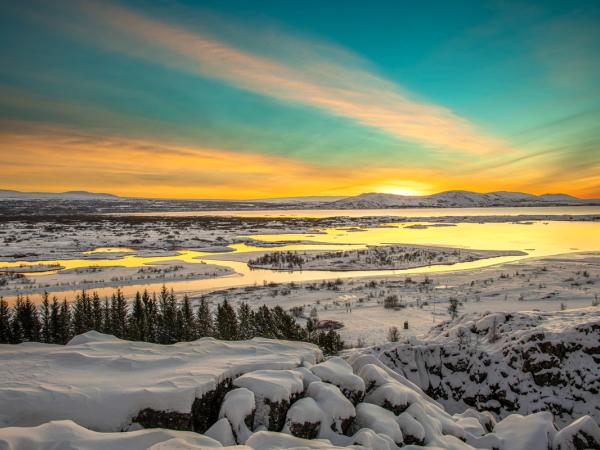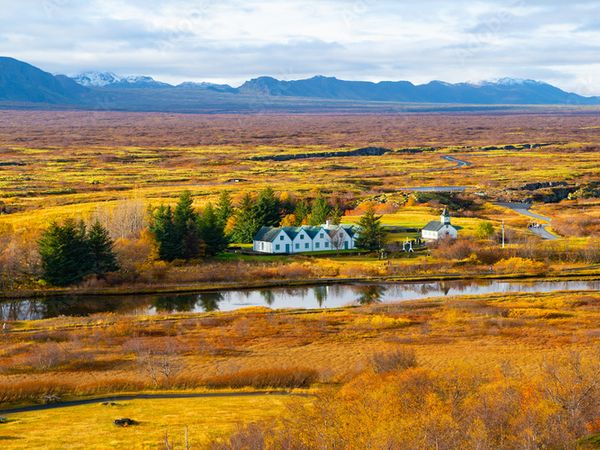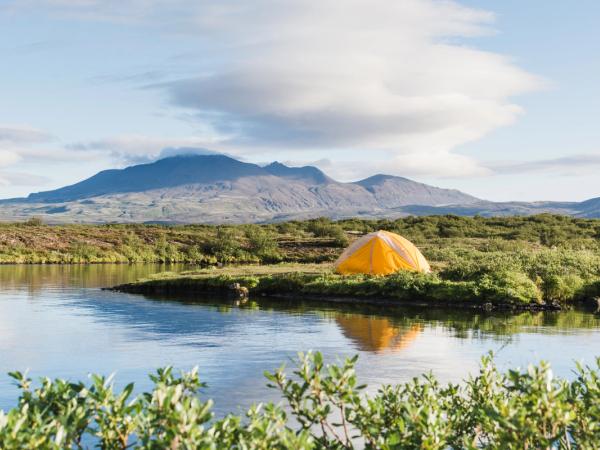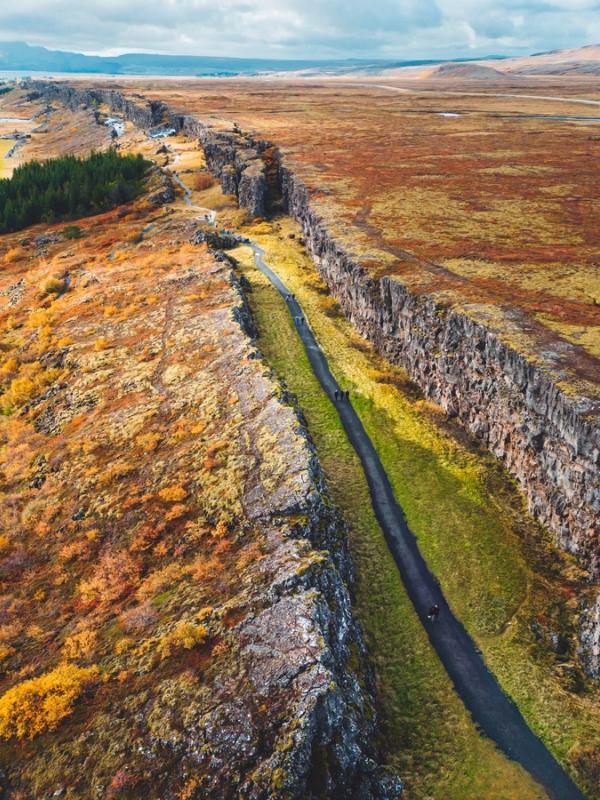
Guide to Thingvellir National Park: Where History Meets Geology
Ever stood with one foot in North America and one in Europe? You can do that at Thingvellir. This isn't your normal park - it's where the ground splits open right in front of you, super-clear water fills the cracks between continents, and you can walk where Vikings set up the world's oldest parliament over 1,000 years ago. Just a quick drive from Reykjavik, Thingvellir mixes amazing natural scenery with cool history in a way you won't find anywhere else.
Key Takeaways
- Thingvellir sits where the North American and Eurasian tectonic plates pull apart
- Home to the Althing, one of the world's oldest parliaments (started in 930 AD)
- Part of Iceland's Golden Circle route
- You can snorkel between continents in clear water
- Just 45 km (40-50 minute drive) from Reykjavik
- The walk to Öxaráfoss waterfall is easy and pretty
- May is a good time to visit - OK weather with fewer tourists
- No hotels in the park, but camping opens June to September
What's Thingvellir National Park?
Þingvellir (often spelled Thingvellir in English) was Iceland's first national park, established in 1930 to protect its nature and history. The park covers about 24,000 hectares, with Lake Thingvallavatn (Iceland's biggest natural lake) at its center.
The name comes from the Old Norse words "Þing" (assembly) and "vellir" (plains), telling you what the place was used for. It's part of Iceland's Golden Circle tourist route, which also includes the Geysir hot springs and Gullfoss waterfall.
As a UNESCO World Heritage Site (since 2004), Thingvellir gets thousands of visitors each week. Recent counts show over 2,600 daily visitors during busy times. People come to see the park's beauty and learn about Iceland's past.
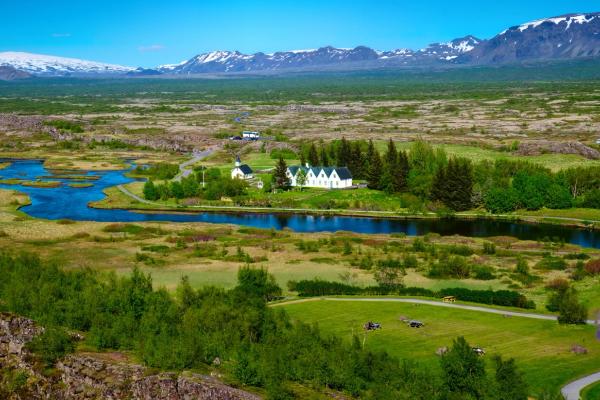
Historical Importance
Thingvellir isn't just a pretty place—it's where Iceland began. Around 930 AD, Viking settlers started the Althing here, one of the world's oldest parliaments.
The Althing was where leaders met yearly to settle fights, make laws, and handle community matters. At the Lögberg (Law Rock), the law speaker would recite laws from memory, since they had no written records.
Significant events at Thingvellir include:
- The switch to Christianity around 1000 AD, a deal that stopped civil war
- The end of Iceland's freedom in 1262, when the island joined Norway
- The 1944 start of Iceland's modern republic, held at Thingvellir to link to the past
For Icelanders, this park is their cultural heart—a place where their nation grew through talking, not fighting.

Geology
Walking through Thingvellir is like seeing geology in action. The park sits in a valley where the North American and Eurasian tectonic plates pull apart by approximately 2 cm each year.
This movement creates some cool landscapes:
- Almannagjá: A big canyon at the edge of the North American plate, several kilometers long and up to 40 meters wide
- Silfra Fissure: A water-filled crack between the plates where you can see up to 100 meters through the water, great for diving
- Thingvallavatn Lake: Iceland's biggest natural lake (84 km²), formed by the plates moving, and up to 114 meters deep
- Öxaráfoss Waterfall: Where the Öxará River drops over the Almannagjá cliffs. It is gorgeous all year round
The park changes slowly as the plates keep moving apart. Walking along the cracks, you see geology happening right before your eyes.
The moss-covered lava fields that cover much of the park originated from ancient volcanic eruptions. These fields, with their open cracks, look like something from a fantasy movie.
Location & How to Get There
Thingvellir is about 45 km northeast of Reykjavik, making it an easy stop on any Iceland trip. It’s one of the three stops (together with Geyser and Gullfoss Waterfall) that make up the Golden Circle, Iceland’s most popular route. You can visit all year round, although winter requires extra preparation.
By Car: Driving is the easiest way to get there. From Reykjavik, take the Ring Road (Route 1) north, then Route 36 east to Thingvellir. The drive takes 40-50 minutes in good weather. The roads work fine for normal cars in summer; winter driving needs 4WD.
Parking: Several parking lots (P1-P5) are available, costing 500-1,000 ISK per day, payable onsite or via checkit.is. The main lot at Hakið (P1) is near the visitor center and has a good view of the park.
By Bus: If you're not driving, several companies offer daily Golden Circle tours that stop at Thingvellir. These tours start around 10,000 ISK ($78) and can be booked online or through your hotel.
Visitor Center: Located near the P1 parking lot, the visitor center shows the park's history and geology, plus a short film about Thingvellir. It's open daily (summer: 9am-8pm; winter: 9am-5pm).
Things to Do in Thingvellir
Thingvellir has stuff for all kinds of travelers, from history buffs to adventure lovers.
Snorkeling and Diving in Silfra
One of the coolest things to do at Thingvellir is diving or snorkeling in Silfra Fissure, where you float between two continents in super-clear glacier water. The water is cold (2-4°C year-round), but you can see up to 100 meters ahead, which makes the cold worth it.
Tours run through companies like Dive.is and Arctic Adventures. Snorkeling tours (1-2 hours) cost around 20,000 ISK ($155), and diving tours. They provide drysuits, but book early, especially in the summer.
To be able to dive in Silfra, you need to have a drysuit certification.
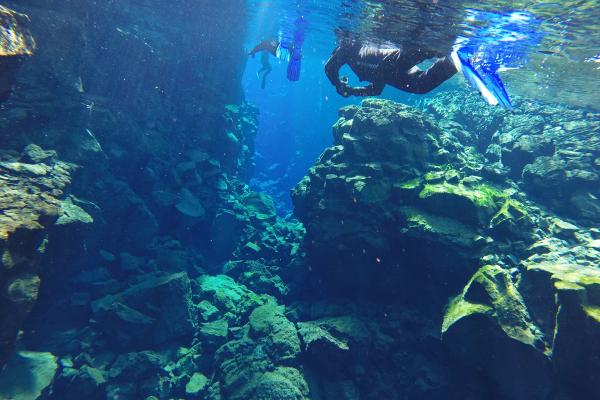
Hiking
The park has several marked trails for all fitness levels:
- Almannagjá and Historical Trail (2-3 km, 1-1.5 hours): Easy walk passing the Lögberg and Öxaráfoss waterfall.
- Silfra and Flosagjá Loop (4-5 km, 2-3 hours): Medium hike with water-filled cracks and lake views.
- Mount Syðstasúla Climb (13 km round-trip, 6-7 hours): Hard hike to the park's highest point (1,085 meters) with panoramic views.
The walk to Öxaráfoss waterfall is nice and easy for most people. The waterfall isn't Iceland's biggest, but the walk through the valley is worth it. I always say it’s the perfect gateway to Iceland’s nature.
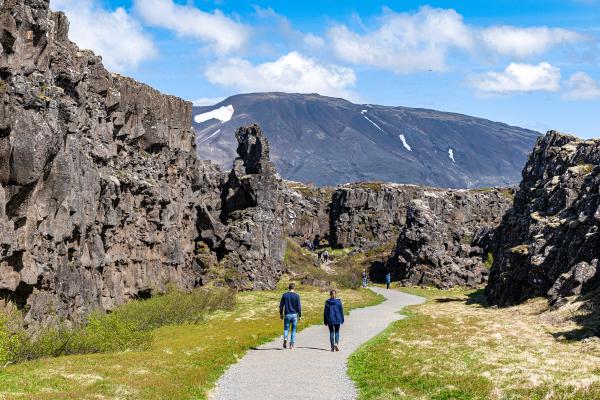
Fishing
Lake Thingvallavatn is home to unique species of Arctic char and brown trout. You need fishing permits, which can be obtained at the visitor center or online, and there are rules in place to maintain healthy fish populations. Fishing season runs from May to September.
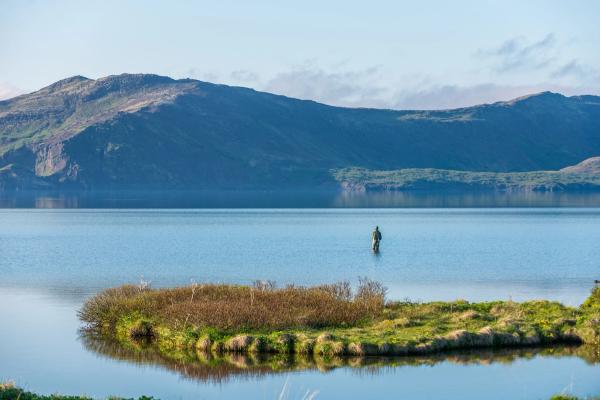
Photography
Thingvellir's landscapes, clear waters, and historic sites are great for photos. The best light comes early morning and late evening. In the summer, the Midnight Sun provides magical lighting, while in winter, you may be able to see the Northern Lights.
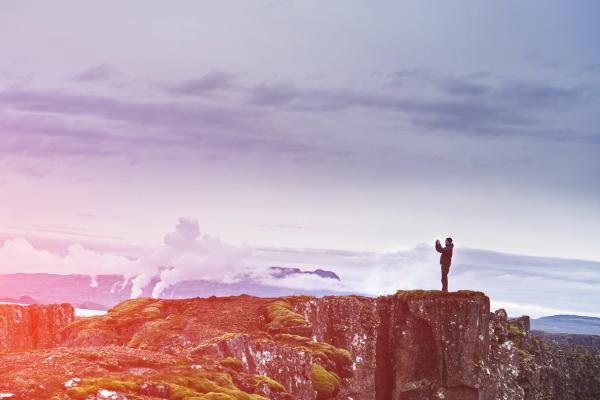
Things to Do Nearby
Thingvellir's spot makes it easy to add other attractions to your visit:
Other Golden Circle Sites
Geysir Hot Springs is just 50 km away (a 35-minute drive), where you can watch the Strokkur geyser erupt every 5-10 minutes, shooting water up to 30 meters high. The area features bubbling mud pots and steaming vents, showcasing Iceland's volcanic side. There's a visitor center with info about geothermal energy and a restaurant serving Icelandic food.
Just 60 km from Thingvellir (a 50-minute drive) is Gullfoss Waterfall, one of Iceland's biggest and most famous waterfalls. The "Golden Falls" drops 32 meters in two steps into a rocky canyon. You can view the falls from different spots, and on sunny days, you might see rainbows in the spray. There's a small café and gift shop where you can get soup and coffee.
Laugarvatn Village
Just 20 km from Thingvellir (20-minute drive), the small village of Laugarvatn sits by a naturally hot lake. The Fontana Geothermal Baths are the main attraction, with hot pools, steam rooms, and bread baked in hot sand. Entry is about 5,490 ISK ($43), and you can rent towels.
The village has several places to eat and stay, from cheap guesthouses to more upscale hotels. Try the local bakery's rye bread, which is baked by burying dough in hot sand for 24 hours, making a sweet, dense bread that's great with Icelandic butter.
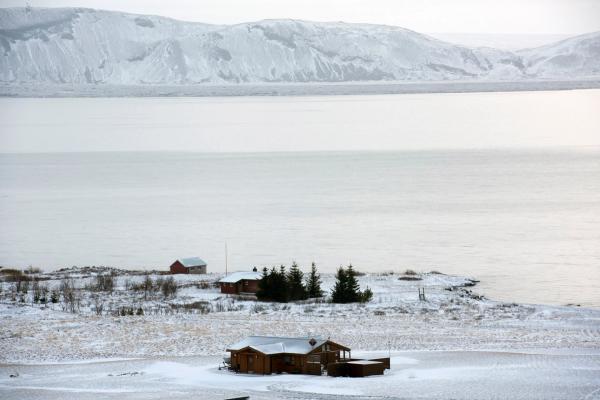
Horseback Riding
Riding an Icelandic horse is a fun way to see Iceland. These small, tough horses have a special gait called tölt, which is smooth and fast without bouncing you around. Several places near Thingvellir offer rides for all skill levels.
Several companies offer 1-3 hour rides through lava fields and meadows, starting at 10,000 ISK ($78). They cater to both beginners and pros, offering small groups for more personalized attention. Tindhestar has custom tours, including evening rides under the Midnight Sun in summer. They also run multi-day trips for a fuller experience. Guides provide you with all the necessary gear, but be sure to wear good shoes and the proper clothing.
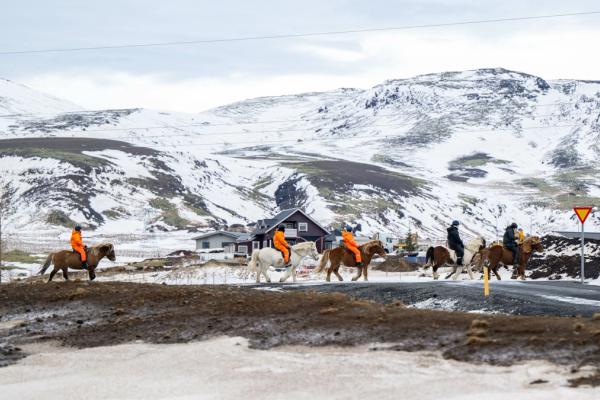
Kerid Crater
About 35 km from Thingvellir (a 30-minute drive) is Kerid Crater, a volcanic lake with red slopes and blue-green water. The crater formed about 3,000 years ago when a volcano erupted and collapsed. The hole is about 270 meters long, 170 meters wide, and 55 meters deep.
A nice 1-km trail goes around the rim, with views of the water and the surrounding area. You can also walk down to the lake on a marked path. Entry costs about 600 ISK ($5) to maintain the trails and protect the site. The bright colors make great photos, especially on sunny days when the water looks extra blue against the red rock.
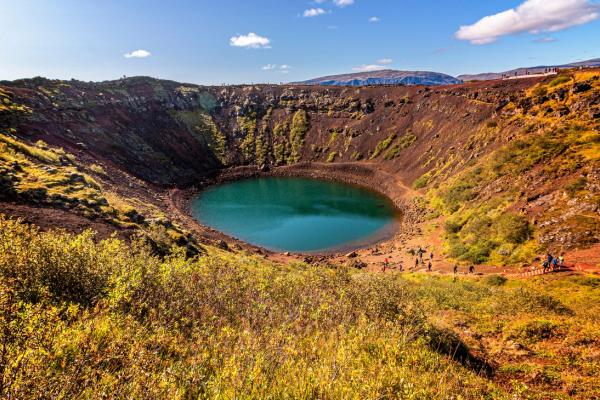
Best Time to Visit
Thingvellir was Iceland’s third most-visited spot in 2024, so timing your visit is key. Plus, each season here offers something different.
Summer (June-August)
Summer has long daylight, with June's Midnight Mun barely setting, so you get almost 24 hours to explore. The weather is mild, usually 5-15°C, good for outdoor activities. All trails are open and easy to walk, so you can see everything.
However, summer brings lots of tourists to Iceland. Thingvellir gets crowded, especially from 10 am to 4 pm when tour buses come from Reykjavik. Hotels and rental cars are more expensive, and booking in advance is recommended. If you visit in summer, go early in the morning or evening to avoid crowds.
Fall (September-October)
Fall is a good middle option. Crowds thin out after August, giving you more space. You might see Northern Lights, especially in late September and October, as nights get longer. The landscape takes on vibrant colors as plants change, making it great for photos.
The downside is cooler temperatures, more rain, and wind. Daytime temperatures usually range from 0 to 10°C, and storms pass through more frequently. Bring waterproof gear and layers to stay warm. Some higher trails might close early depending on the weather.
Winter (November-March)
Winter makes Thingvellir a snowy wonderland. The white landscape against dark waters makes for great photos. This is when Northern Lights are best, with dark skies from early afternoon to late morning. You'll see way fewer tourists, so you get more alone time with nature.
Winter problems include short days (as little as 4-5 hours in December), so plan carefully. Many trails get icy or snow-covered, making some areas hard to reach without the right gear. Temps can drop below freezing, often -10°C to 0°C. If you visit in winter, bring ice grips for your boots, wear layers, and consider hiring a guide who knows which spots are safe.
Spring (April-May)
Spring brings more daylight and the first signs of life in the park. Flowers start to show in sheltered spots, and birds return to Lake Thingvallavatn. Crowds are not as large as they are in summer, so you have good access without the big crowds. May has OK weather with fewer tourists than summer.
Spring weather in Iceland changes fast, sometimes within hours. Trails might be muddy from melting snow, and late snowfalls can happen even in May. Temperatures usually range from 0-10°C, but vary significantly. Wear layers and bring waterproof gear for this changing season.
What to Wear
Iceland's weather changes fast, so bring layers whenever you visit:
Year-round essentials:
- Waterproof jacket and pants
- Good hiking boots
- Layers (base layer, mid layer, outer shell)
- Hat and gloves (even in summer)
- Sunglasses (for glare off water or snow)
Summer additions:
- Light fleece
- Bug spray (for calm days)
- Sunscreen (even in cool weather)
Winter necessities:
- Thermal underwear
- Heavy warm jacket
- Winter boots with good grip
- Warm hat, scarf, and gloves
- Ice grips for boots
For snorkeling, companies give you drysuits, but bring a swimsuit to wear under it and thick socks for comfort.
Campsites Nearby
Camping lets you experience Thingvellir's changing light and peaceful atmosphere all day round. The park has five well-equipped campgrounds, open from June 1 to September 30 (depending on the year):
Leirar Section (4 sites near the information center):
- Fagrabrekka: Pretty site near Almannagjá
- Syðri-Leirar: Popular for being close to the visitor center and facilities
- Hvannabrekka: Quieter spot away from main facilities
- Nyrðri-Leirar: Open spaces with views of the valley
Vatnskot Section:
- Lakeside campground with direct access to fishing and water views
Facilities:
All campgrounds have flush toilets, electricity hookups, and shared cooking areas. The main campground, Syðri-Leirar, also features hot showers, washing machines, and a small shop.
Costs and Booking:
- Camping costs around 1,800 ISK per person per night (~$14)
- Children under 13 camp for free
- Electricity hookups cost extra (~1,000 ISK per day)
- Reservations recommended in July-August, available online or at the service center
Why Is Thingvellir Worth Visiting?
Thingvellir offers experiences you simply can't find elsewhere:
- Stand Between Continents: Where else can you walk between tectonic plates and see the earth literally pulling apart?
- Touch Living History: Standing where Vikings created one of the world's first parliaments connects you to over 1,000 years of democratic tradition.
- Unique Underwater Experience: Snorkeling or diving in Silfra's crystal-clear waters between continents is a once-in-a-lifetime adventure.
- Easy to Reach: Unlike many natural wonders, Thingvellir is just 45 minutes from a major city, making it easy to visit even on a short day-trip.
- Great for Photos: The dramatic landscapes, clear waters, and historical sites offer countless photo opportunities in any season.
- Golden Circle Hub: Its location makes it a perfect starting point for exploring Iceland's most famous tourist route.
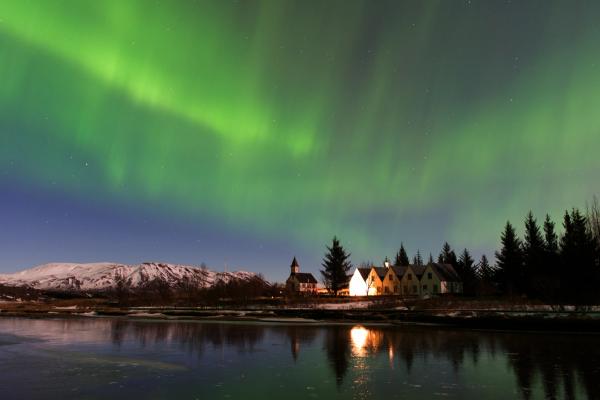
Conclusion
Thingvellir National Park shows Iceland in miniature—a place where powerful natural forces and human history come together to create something truly special. From walking through the dramatic rift between continents to standing where Vikings established their parliament, the park offers experiences that stay with you long after your visit.


